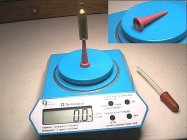Curious as to what procedure everyone is using for water weighing cases. I am using the below item from 21st Century
http://www.21stcenturyshooting.com/Primer_Pocket_Plugs.php
Am also using an analytic balance for weighing. I've tried an eye dropper and a styringe for dispensing the liquid into the case. I have tried using water, 91% isopropyl alcohol, rubbing alcohol, H2O with a surfactant but am still having problems getting consistency. I weigh the case 5 times and there is quite a lot of spread.
So how do you guys do it ?
http://www.21stcenturyshooting.com/Primer_Pocket_Plugs.php
Am also using an analytic balance for weighing. I've tried an eye dropper and a styringe for dispensing the liquid into the case. I have tried using water, 91% isopropyl alcohol, rubbing alcohol, H2O with a surfactant but am still having problems getting consistency. I weigh the case 5 times and there is quite a lot of spread.
So how do you guys do it ?











